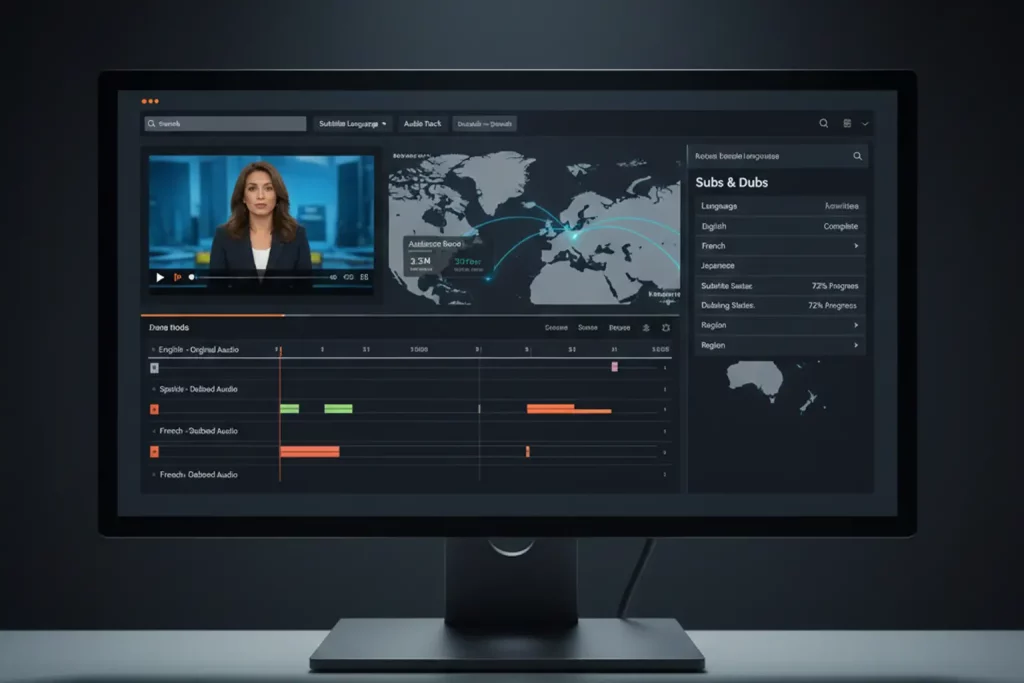Automatic transcription has become a game-changer for businesses across various industries. From simplifying administrative tasks to boosting productivity, these tools reshape how professionals handle audio and video content. In this guide, we’ll dive into everything you need to know about automatic transcription—what it is, how to choose the right tool, and its pros and cons. Let’s explore how these tools can transform your workflow.
What is Automatic Transcription?
Automatic transcription refers to the process of using artificial intelligence (AI) to convert spoken words in audio or video files into text. Unlike traditional methods that rely on human transcriptionists, automatic transcription leverages advanced algorithms to perform this task in a fraction of the time.
These tools analyze sound waves and match them to words stored in their extensive language databases. By processing accents, tones, and speech patterns, they aim to transcribe with as much accuracy as possible, although results can vary depending on the tool and audio quality.
Automatic transcription tools are widely used in various sectors, including media, education, healthcare, and business. They make it easier to create meeting notes, interviews, podcasts, or any recorded material that needs to be converted into text. The key advantage? Speed. An AI-driven tool can complete a task that might take a human hour in mere minutes.
Why Choose Digital Nirvana for Your Automatic Transcription Needs?
At Digital Nirvana, we’ve crafted our automatic transcription services to provide businesses with top-tier accuracy, speed, and convenience. Our AI-driven platform is built with cutting-edge technology that offers real-time transcription for various industries, including media, education, legal, and more. Whether you want to transcribe interviews, meetings, or entire webinars, our solution will help you meet those demands efficiently.
Our focus on precision sets Digital Nirvana apart from others in the market. We understand that transcription errors can lead to misunderstandings, missed opportunities, or costly mistakes. Our system is continuously trained and refined to capture even the most nuanced speech, including industry-specific jargon and technical terms. Our platform offers an accuracy rate that rivals human transcription but without the delays and higher costs that often come with manual transcription.
Additionally, we understand that your business needs more than just transcription. That’s why our services easily integrate with your existing workflow tools, whether you’re managing media assets, generating captions, or performing detailed analysis of audio data. Our user-friendly platform enables businesses to streamline their content creation process, saving time and resources.
Security is another key factor we prioritize. At Digital Nirvana, we treat your data with the utmost care, ensuring that all files are encrypted and stored securely. We comply with industry-standard regulations, so you can have peace of mind when using our platform for sensitive business information.
In a world of paramount efficiency and accuracy, Digital Nirvana’s automatic transcription services provide the perfect balance. Whether you’re looking to transcribe a high volume of audio content or need precise, real-time transcription, we’ve got the solution to make it happen—quickly, securely, and reliably.
Experience the Digital Nirvana difference today and see how our transcription services can transform your business.
How to Choose the Right AI Automatic Transcription Tool
Choosing the best automatic transcription tool can be tricky with so many options available. Here are a few important factors to consider when evaluating these tools:
- Accuracy: Not all tools are created equal. Accuracy rates vary, with some tools being better suited for specific industries. Look for software that can handle different accents, technical terms, or jargon specific to your field.
- Turnaround Time: If time is of the essence, you’ll want a tool that can transcribe files quickly. Many tools offer real-time transcription, while others take longer to process.
- Integration Capabilities: Does the tool integrate with other software you use? For example, if you use a project management tool or video editing software, check if the transcription tool can seamlessly fit into your existing workflow.
- Customization: Some transcription tools allow you to train their AI by adding industry-specific terms or custom words. This can be useful if your field has unique jargon that wouldn’t be commonly recognized by general-purpose software.
- Cost: Most automatic transcription tools operate on a subscription or pay-per-use model. While free versions are available, premium options often deliver better accuracy and more features.
Considering these aspects, you can choose the best tool for your business needs.
How Does Automatic Transcription Help Businesses?
Automatic transcription isn’t just a trendy tech tool—it’s an invaluable resource for businesses that need to save time and cut costs. Here’s how it benefits various industries:
- Time Savings: Manually transcribing interviews, meetings, or webinars can eat up hours of valuable time. Automatic transcription tools dramatically reduce this effort, allowing teams to focus on more strategic tasks.
- Improved Productivity: In journalism, marketing, or law, time spent on transcription means less time for creativity or case-building. AI-powered tools allow workers to retrieve meaningful conversations, speeches, or data almost instantly, allowing for faster decision-making and better productivity.
- Cost Efficiency: Hiring human transcribers can get expensive, especially for businesses with high transcription demands. Automatic transcription tools offer a cost-effective alternative without sacrificing too much accuracy—depending on the tool and use case.
- Accessibility: In addition to saving time and money, automatic transcription improves accessibility by converting audio content into text for deaf or hard-of-hearing individuals. Businesses prioritizing inclusivity can use these tools to broaden their content’s reach.
- Enhanced Searchability: Transcribed documents can be easily indexed, making it simpler to find specific information. This is especially helpful when reviewing large volumes of content, such as conference speeches or long podcasts.
By adopting automatic transcription, businesses are streamlining their processes, improving accessibility, and ultimately saving valuable resources.
Types of Automatic Transcription Tools
Automatic transcription tools come in various forms, each tailored to specific needs. Here’s a breakdown of the main types:
1. General-Purpose Transcription Tools
These are widely available and offer reasonable accuracy for everyday transcription, such as converting interviews, podcasts, or webinars into text. They work well for businesses seeking a simple, affordable option to handle common transcription tasks.
2. Industry-Specific Transcription Tools
Certain industries, like legal, healthcare, or media, require specialized transcription tools that can recognize specific jargon or phrases unique to that field. For example, medical transcription tools, including complex medical terminology, can accurately transcribe doctor-patient conversations.
3. Real-Time Transcription Tools
These tools offer live transcription, making them ideal for meetings, lectures, or events where participants need real-time access to spoken content. They’re especially useful for people with hearing impairments or for live broadcasting of important business events.
4. Speech Recognition Software
Though closely related to transcription tools, speech recognition software often includes additional functionalities, like voice commands and dictation. These tools help professionals in fields such as law or healthcare dictate notes on the go, improving workflow efficiency.
By choosing the right type of transcription tool, businesses can ensure they’re getting the best fit for their unique needs.
Pros of Using Automatic Transcription Tools
Automatic transcription tools offer numerous benefits that make them attractive for businesses. Here are the main advantages:
1. Speed
One of the biggest advantages of using AI-driven transcription tools is speed. Transcribing hours of audio content by hand can take forever, but automatic transcription tools can complete the job in minutes.
2. Convenience
The ease of uploading an audio file and receiving a transcription in your inbox is unbeatable. For teams managing multiple projects, it’s a stress-free way to handle large volumes of transcription work without needing extra staff.
3. Accuracy for Standard Content
For general content without too much background noise or technical language, automatic transcription tools often provide high accuracy. This is sufficient for most meetings, interviews, or podcasts.
4. Affordability
Investing in an AI tool is far more cost-effective for businesses that need regular transcription services than hiring human transcribers. Subscription-based models also allow you to scale up or down depending on your transcription needs.
5. Accessibility and Inclusivity
By transcribing audio content into text, businesses make their material accessible to a wider audience, including people with hearing disabilities. It’s a simple but powerful way to promote inclusivity.
Cons of Automatic Transcription Tools
As great as automatic transcription tools can be, they have drawbacks. It’s important to weigh the pros and cons before making a decision. Here are the common downsides:
1. Accuracy Limitations
While AI-driven tools can be fast, they aren’t always 100% accurate. Background noise, strong accents, or poor-quality recordings can all affect transcription quality. For industries that demand near-perfect accuracy, a human transcriber might still be needed for editing.
2. Limited Vocabulary
Even the most advanced AI tools need help with specialized jargon or industry-specific terms. This can be problematic for fields like medicine or law, where precision is critical.
3. Inability to Grasp Context
AI may not understand the context or the subtleties of human conversation. This could result in misinterpretations, especially in cases where a sentence’s meaning depends heavily on tone or intent.
4. Data Security Concerns
Some transcription tools require you to upload sensitive or confidential audio files. Businesses must ensure their data is securely stored and handled according to relevant privacy regulations.
Conclusion
Automatic transcription is quickly becoming indispensable for businesses looking to streamline their workflow, save time, and reduce costs. Whether you’re managing content for podcasts, interviews, or business meetings, these tools can help you boost productivity without sacrificing accuracy. However, choosing the right tool based on your industry and specific needs is essential. Ready to see how automatic transcription can benefit your business? Try a tool today and experience the difference for yourself.
Digital Nirvana: Empowering Knowledge Through Technology
Digital Nirvana stands at the forefront of the digital age, offering cutting-edge knowledge management solutions and business process automation.
Key Highlights of Digital Nirvana –
- Knowledge Management Solutions: Tailored to enhance organizational efficiency and insight discovery.
- Business Process Automation: Streamline operations with our sophisticated automation tools.
- AI-Based Workflows: Leverage the power of AI to optimize content creation and data analysis.
- Machine Learning & NLP: Our algorithms improve workflows and processes through continuous learning.
- Global Reliability: Trusted worldwide for improving scale, ensuring compliance, and reducing costs.
Book a free demo to scale up your content moderation, metadata, and indexing strategy for your media assets with minimal effort and get a firsthand experience of Digital Nirvana’s services.
Frequently Asked Questions
1. How accurate are automatic transcription tools?
Accuracy depends on the quality of the tool and the audio input. High-quality audio with clear speech can result in 80% to 95% accuracy. However, industry-specific jargon, background noise, and strong accents can reduce accuracy rates.
2. Can automatic transcription tools handle multiple speakers?
Yes, most modern tools can differentiate between speakers, but speaker recognition accuracy can vary. Some tools even allow you to label speakers manually.
3. Is automatic transcription secure?
Many reputable transcription tools comply with data privacy laws and use encryption to protect files. However, always review a tool’s security policies, especially when dealing with sensitive information.
4. What industries benefit most from automatic transcription?
Industries like media, legal, healthcare, and business administration benefit the most from automatic transcription, as these fields often deal with large volumes of audio content that need to be transcribed quickly.



